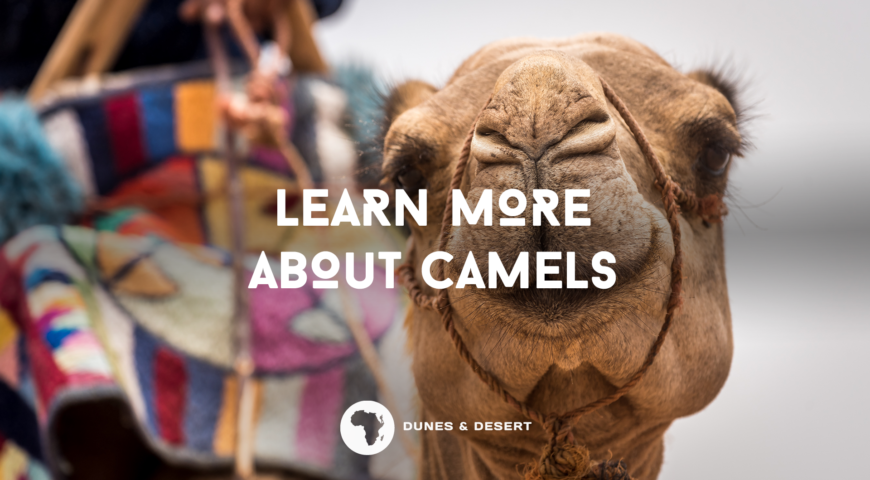
LEARN MORE ABOUT CAMELS
Many of you want to know more about this iconic animal when you book a ride on their backs. Some of you are even quite worried about the way they are treated (walks in the heat, weight of a human on the back …) So we decided to write this article to allow you to learn more about camels in general and to understand how we take care of them especially at Dunes & Desert.
Camel or dromedary?
First of all, the dromedary has only one hump, while the camel has two.
The specie that is commonly known as camel is native of Asia, while the dromedary comes from Africa, and is also called camel of Arabia (Camelus dromedarius).
So when you take a ride with Dunes & Desert, you are on a dromedary !
Filled with fat, the hump allows the camel to travel long distances without having to drink and feed. It’s a kind of reserve. The camel is able to travel 60km per day, using only its reserve of fat. If the camel has not been fed for a long time, we can see its hump fall to the side, as the energy stock runs out.
The dromedary is adapted to the climate of hot deserts (Sahara, Arabian Peninsula …), while the camel lives in the colder deserts of Asia (Mongolia and China). The camel therefore needs a lot more energy because it has to deal with heat and cold, which is why it has two bumps it. Moreover, initially, the dromedary also had two bumps, but they merged over the course of evolution. Incredible, no?

Fun facts about camels
The size of the camel is from 2.20m to 2.50m at the withers and its weight varies between 400 and 1100 kg depending on the breed. It is herbivorous and can live on average up to 25 years.
The camel has very long eyelashes to protect it from sandstorms in the desert. They are also able to close their nostrils for the same reasons.
He has thick, strong lips that allow him to eat thorny plants without hurting himself.
The camel has a wide, elastic foot without shoe, perfectly suited to walking in the sand.
The males drool a lot during the breeding season, it is how they charm the females.
The female gives birth to a single pup, and the gestation lasts 15 months.
Camel already existed in the Horn of Africa during Prehistory and teeth were found in Ethiopia as well as paintings in Somalia and Djibouti.

Camel and water
The camel resists to hard heat much better than other animals, because it has the amazing ability to conserve water, in several ways:
– First, the camel can ingest 100 liters of water in less than 10 minutes, so it is able to rehydrate much faster than any animal.
– Then, he knows how to vary the temperature of his body from 34° to 42°, which allows him to adapt his sweat and thus better conserve water in his body.
– Finally, the camel has a super power: it is able to withstand a loss of water greater than 30%, while for other mammals this loss is fatal from 15%.

Camel and Humans
The relationship between human beings and camels goes back almost to the dawn of time. The nomads used them to transport their loads and thus save themselves during desert journeys in Africa and the Middle East.
Due to its endurance and ability to conserve water, the camel is the most suitable means of transport in the desert. The man will always need him to rally one point to another in places where there is no runway for motor vehicles.
The camels are always attached to each other: it is the caravan. It may seem strange and even cruel, but in fact it’s just that they’re not going anywhere unless they’re guided. The head camel (often a female because they are more concentrated) is driven by a camel driver.

Camels at Dunes & Desert
At Dunes & Desert, we have 15 camels, all living together in a large paddock in the desert around Marrakech. They always have water and food available.
At the end of a ride, we remove the stools, we brush them and bring them back to their pens.
During summer, we only make one ride a day (two the rest of the year), but it is more for the well-being of our camel drivers! The camel resists everything!
The vet visits once a year for vaccination and comes of course more often when the camels are pregnant.
Now that you know everything, you can book one of our camel rides, without worrying about the well-being of our animals, who are treated like who they are : kings of the desert.
Book your trip >> https://www.dunesdeserts.com/en/product-category/nature-en/camels-en/

About Dunes & Désert
Dunes & Desert is adventures designer, specializing in quad and buggy rides, camel rides, stand-up paddling, mountain biking, trekking, hot air ballooning and many other hobbies in Morocco. We offer many activities, including camel rides.
We also suggest you combine a camel ride with quad or buggy experience. Camel ride in the morning, traditional lunch in a Berber village where a family will welcome you in the Moroccan way, and discovery of the desert by quad in the afternoon. Ideal to practice two activities in the same day! This activity is open to all, it is the typical activity not to be missed during a stay in Morocco! It is ideal for both families and groups of friends on holiday.
Other rides are also available in the Agafay desert, near the Lalla Takerkoust Lake. Discover majestic landscapes, at the foot of the Atlas Mountains!
The most difficult will be to choose, but our team is at your disposal at any time to advise you!
Choose the best partner to spend the best moments!

